
by Lori Vande Krol | Nov 20, 2023 | General Productivity, Goals and Priorities, Organization, Planning, Time Management, Tools
There is no question this is a busy time of year. But as we near the end of 2023, there are still a few things you can do to close out the year and prepare for a successful 2024.
1. Spend time on office “maintenance. Schedule a few days to catch up on filing, update your contact database, organize your receipts for the year (send them to Shoeboxed and let them take care of it for you!), empty your email inbox, and/or scan in those piles of paper (I recommend the Fujitsu ScanSnap iX1600 for PC or Mac for this task.) I like to use the last week of the year for these maintenance items. Spending some time to maintain your office productivity systems will help you feel you can start the New Year fresh and accomplish your goals.
2. Fill a bag for donation. Get a trash bag (or box depending on the type of items) and take 10-15 minutes to fill it with items to donate. Drop them off at a shelter, church, Goodwill, Salvation Army, or the charitable organization of your choice before the end of the year to receive your 2023 tax deduction. Help others that may not be as blessed during the holidays and clear out your space at the same time.
3. Crush what’s left of 2023. Plan the remainder of your year to help you prioritize and be intentional about how you want to spend this busy time. Brainstorm a list of personal and work tasks you want to accomplish before yearend. Be sure to review your 2023 goals to determine what is left to accomplish and determine if and how you will do so. Once you have a list of tasks, schedule them. With about 6 weeks remaining in the year, when will you focus on each task? Check out the ProAction Planner as a helpful tool for planning and scheduling.
4. Reflect on the year. Review the good and bad from 2023. What went well? Where did you find challenges? What will you continue doing, start doing, and/or stop doing in 2024? Download and complete our Year in Review Template, using the button below, to help you through the process.
5. Create your 2024 goals. Determine three to five goals for 2024. Why are these goals important? What strategies will you use to reach your goals? What tools or resources do you need to accomplish them? Check out our past blog, Goal Setting is Hard, for more goal-setting tips.
While each of these takes some time and focus, the value received is well worth it. Be sure to schedule them in before your end-of-year calendar is full.

by Lori Vande Krol | Sep 7, 2023 | Goals and Priorities, Habits, Planning, Time Management, Tools
“I’ve tried time blocking in the past and it’s never worked for me.”
This was a recent statement from a client who I was helping with time management. Once we dug in more, we found it wasn’t that time blocking was an ineffective method, but that it wasn’t being applied in the most ideal way for him. This isn’t an uncommon complaint. In fact, even David Allen, productivity guru and author of Getting Things Done, used to argue against time blocking. He preferred a simple calendar with only the necessary appointments and deadlines. But eventually, he realized time blocking can work well for many people and even began practicing it himself.
Let’s dive a little deeper into what time blocking is, who can benefit (*hint* – everyone!), and how it might work best for you. I also share tips, tools, and resources to support your time-blocking habits.
Wikipedia defines Time Blocking as:
“A productivity technique for personal time management where a period of time—typically a day or week—is divided into smaller segments or blocks for specific tasks or to-dos. It integrates the function of a calendar with that of a to-do list. It is a kind of scheduling.”
While I agree with this definition of time blocking, there is much more to it than this.
Who should use a time-blocking technique?
Time blocking is best used for people who:
- Have a busy schedule and need to be very intentional about how they use their time,
- Have a fairly open schedule that can be wasted away if time is not blocked to work on specific tasks and projects (aka Parkinson’s Law),
- Reach the end of a day or week feeling stressed and unaccomplished, wondering where the time went,
- Juggle multiple areas of work and life,
- Struggle to find time for focus and big-picture thinking,
- Deal with constant interruptions, or
- Spend too much time “reacting” to the day’s urgencies.
If we are honest, isn’t this all of us at one point or another? I believe that some form of time blocking can work for almost everyone. The key is finding the method, or combination of methods, that works best for you.
Types of Time Blockers
While there are many different ways to apply time blocking to your calendar, we can simplify it by looking at three key methodologies.
1. The Serious Blocker divides their day into specific blocks of time, each dedicated to accomplishing a specific task, or group of tasks. They start each day, or week, with a concrete schedule that lays out what they will work on and when. A serious blocker will work to bunch related tasks (i.e. “task batching”) such as email processing, social media creation, or phone calls, into one block.
In addition, the serious blocker lumps meetings together. That way, they can spend larger chunks of time on focused projects and tasks versus shorter amounts of time spread between meetings throughout the day. This type of time blocking requires more work upfront, and potential cooperation from others, to reschedule meetings that will better fit your ideal schedule.
2. The Flexible Blocker applies time blocking in a broader way, with more general blocks that are flexible depending on what comes up throughout the day. This works well when your days are less predictable and require a more “reactive” approach (e.g. a customer service specialist). Some argue that these types of schedules aren’t compatible with time blocking, but when your workday is often run by outside forces, it’s easy to lose sight of your own goals. Even a simple version of time blocking can help you gain a greater sense of control over unpredictable schedules. You can still block off time for your “reactive work,” and then be more intentional about time during the day that allows for some planning and control (regardless of how little).
3. The Time Themer chooses themes for work they will do during certain time blocks. This is the most open-ended version of time blocking. “Day theming” is the most popular example where you choose a theme for each day of the week. For example: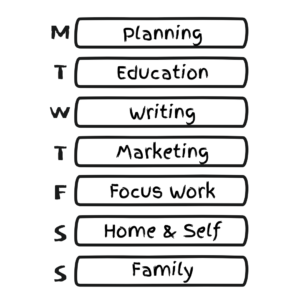
Any open time is spent on that day’s area of focus. Day theming minimizes the choices you need to make about what to work on throughout the day. You look to your theme and choose tasks based on that theme.
You can also use time theming to break up your day by assigning themes to blocks of time throughout the day. An example of this would be: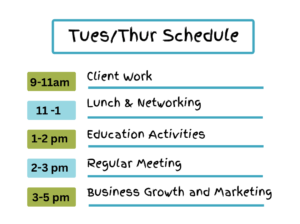 The schedule may be the same every day or may differ throughout the week. In the example above, Tuesday and Thursday have the same “themed schedule” while the other days look different. In the resources section below I share a template called My Productive Week that can be of great assistance in defining your daily “theme blocks.”
The schedule may be the same every day or may differ throughout the week. In the example above, Tuesday and Thursday have the same “themed schedule” while the other days look different. In the resources section below I share a template called My Productive Week that can be of great assistance in defining your daily “theme blocks.”
Most people do not fit perfectly into one time theming option but instead use a combination. For example, having a schedule of daily themes can make it easier to determine what tasks to put into working time blocks when using the “serious” or “flexible” blocking methods.
The Benefits of Time Blocking
While it takes some work, and potentially a change in mindset, the following benefits of time blocking show the value of this time management methodology.
- Your need to make decisions at every point in time throughout the day is minimized because your schedule is pre-defined. This saves time and energy throughout your week.
- If you get easily distracted or off-track, a time-blocked calendar will help to pull you back into focus. In addition, time blocking helps to fight multi-tasking allowing you to focus all of your energy on one thing at a time.
- You will get more realistic about how long things take. We often underestimate the time tasks and activities take, and this is a concrete way to see that. This will get better over time.
- When you see your priorities laid out in your finite calendar, you can more easily say “no” to those things that don’t fit.
- You are more likely to accomplish your goals if you schedule specific, intentional time to work on them.
- It will be easier to relax during your leisure time as you know you have a plan to get everything done.
“A 40 hour time-blocked work week, I estimate, produces the same amount of output as a 60+ hour work week pursued without structure.”
– Cal Newport, Author of Deep Work –
Tips for Effective Time Blocking
Below are key things to consider when working to design and maintain your own time-blocking routine.
- Build your time-blocking methodology into regular weekly planning. Look at your upcoming schedule, deadlines, and tasks and fit it all together to create a week that takes into account your goals, priorities, and commitments.
- Review your schedule daily and reset your week as necessary.
- Your routines and habits should be incorporated into your time blocks.
- Leave a time block for an overflow of tasks that take longer than expected or for unexpected appointments or to-dos that come up during the week.
- Once your week is planned, make intentional choices when straying from that plan.
- Leave space between, or within, blocks for transition, travel, time, and necessary breaks.
- Bunch your urgent but less important work together and dedicate a pre-determined amount of time to it. This allows for longer, uninterrupted time for focused work.
- Consider your daily rhythms in your schedule. When are you most energetic, productive, or focused?
- Evaluate your time-blocking schedule regularly and make needed changes.
- When scheduling time blocks for focused work, find a quiet location free of interruptions and/or block notifications on your computer and phone.
- Consider whether you want to block time on weekends (or other non-working days). You may want to leave these times open to allow freedom and flexibility with leisure time.
Most importantly, remember your time-blocked schedule is a guide to assist you with creating your most productive week. If you try to stick to it perfectly, especially at first, you will get overwhelmed when things come up that cause needed changes to your schedule. Review, reset with intentional decisions, and move forward. You might look at time blocking as a game or a puzzle. How can I fit it all in the most optimal way? But as with any game, you will make mistakes, learn along the way, and get better with practice.
Time Blocking Resources
The following resources can help you create your own time-blocked schedule.
- My Productive Week Template
I have created this tool as a template to build your “puzzle” for your time-blocked weekly calendar. It is to be used as a guide – along with your weekly schedule, goals, and tasks – for your weekly planning. The template can be completed digitally or printed.
- The ProAction Planner:
If you prefer to do your weekly planning with a paper planner, which allows for better mental processing and decision-making, the ProAction Planner is a tool to support all of the important areas of planning and time management. A paper planner provides an easy visual that stays in front of you throughout your day. If using a paper planner, I recommend using a writing instrument that allows for change throughout the week. My tool of choice is the Frixion Clicker Erasable Gel Pen, in multiple colors.
- Online Calendar (Outlook, Google, Other)
Whether or not you use a paper planner for weekly planning, the majority of us use an online calendar to keep track of our meetings and appointments. If you choose to use an online calendar for time-blocking, consider color-coding the blocks of time you wish to be flexible. I like to color my movable time blocks with yellow and mark them as “free.” Also consider those time blocks that you want to protect, mark them as busy, and consider them a meeting with yourself.
- Pomodoro Technique and Tools
The Pomodoro Technique is a method in which you focus for timed periods with short breaks between blocks. Learn more about this technique on their website and search for apps like this one to support the technique.
If you are interested in some assistance in determining and implementing the right time-blocking solution for you, please reach out. I’d love to help.

by Lori Vande Krol | Feb 23, 2023 | General Productivity, Time Management, Tools
Do you like to listen to podcasts or audio books when you travel? Are you an audio learner and would rather listen to a book than read it? I often get requests from clients for recommendations of what to listen to related to productivity and time management. While I have a handful of these I typically recommend, I decided to reach out to my colleagues, fellow Productivity Consultants and Coaches, to see what they enjoy listening to and recommend to others.
The following list, available as a download, provides links to 18 podcasts and 10 audiobook recommendations. All relate to areas of productivity in work and life such as time management, habits, leadership principles, business growth, efficiency, focus, prioritization, and more. Some you may have heard of but I think others will surprise you.
Let us know if we are missing any of your favorites!

by Lori Vande Krol | Feb 6, 2023 | General Productivity, Goals and Priorities, Habits, Planning, Time Management
Julie reached out because she had reached a point of extreme frustration and overwhelm. She felt she was constantly trying to catch up, never finding time for her “important but nonurgent” tasks and projects, always worried about what she might be missing, and therefore not truly enjoying her work or personal time. Julie was always reacting to the latest emergency, others’ priorities become her priorities, and she would reach the end of the day, the week, and the year feeling drained, overwhelmed, and unaccomplished. Does this sound familiar?
After talking with Julie, we established that one change she needed was to incorporate a better system and tools for planning her time – her years, months, weeks, and days. An effective plan, and strategy to follow and maintain it, allows Julie to better understand her goals and priorities, and to make better decisions and choices throughout her days. Here I share ten proven strategies for incorporating effective planning into your own days and weeks.
1. Clarify your goals and priorities.
What is important to you in work and life? What do you hope to achieve in the long-term and short-term? If you aren’t clear on what your goals and priorities are, you can never know if you are working on the right thing at any point in time. This clarity will be the basis for your plan and the choices you make throughout the day.
2. Break down your goals into strategies and milestones.
As an elephant lover, I hate to use the saying “How do you eat an elephant? One bite at a time.” But it is a good metaphor for attacking your long-term and short-term goals. Once you know what you want to accomplish, you can break your goals into smaller pieces by defining the strategies you will use and when you will achieve various milestones.
3. Create your habits and routines.
Without good habits and routines, it is easy to let your days and weeks slip away without focusing on what is most important. Spend some time figuring out how you will incorporate the needed activities and time to reach your goals. List the habits you want to follow annually, monthly, weekly, and daily. Define daily routines such as tasks or actions you will take each morning, start of day, end of day, and evening.
4. Establish your boundaries.
It is likely that you will need to establish new boundaries in order to be successful in reaching your goals and sticking with your plan. Some examples might include:
- I will return emails and phone calls within 24 hours.
- I will take 1 day to review any new priorities, tasks, or projects before providing an answer.
- I will say “no” to anything that does not support my annual goals.
- I will not take on new volunteer positions this year.
- I will not respond to email or text after 6pm or on weekends.
- I will be in bed by 11pm and up by 7am each day.
Choose boundaries that work for your needs and personality and that will help you to reach your goals.
5. Get the right people on board.
Who will be impacted by your goals, strategies, habits, and routines? Do you have someone to help hold you accountable? Who can help support your plan? Be sure these people are aware of your plan, your boundaries, and how they can help you be successful.
6. Clear your space and your mind.
Take time regularly to clear your physical, digital, and mental space. If necessary, set aside a day or more to create an environment where you can focus and be intentional.
7. Determine the right tools.
What tools can you use to support your planning, focus, and daily intention and action? My favorite tools for daily and weekly planning are Microsoft Outlook/Tasks and the ProAction Planner. Do your research and find tools that will allow you to plan, reflect, track, and maintain. When working with others, it is also important to implement tools that will help you plan, collaborate, and track projects and tasks with them. Examples include Microsoft Planner and Teams, Asana, Trello, and Google Workspace. These are just a few of the many options available. Be sure to determine your needs and find what will best fit those needs.
8. Plan your weeks and days.
Set aside time regularly to plan your weeks and days based on your annual goals, habits, routines, and other priorities. Block time for the important, but nonurgent, projects and tasks. While it is rare that your week will go exactly as planned, having this basis as you begin your week will provide control and perspective, and allow you to make better-informed decisions when new urgencies arise.
9. Track.
Incorporate a system to track progress on your projects, goals, and habits. Review this regularly in order to evaluate and reset as needed throughout the year. You might also consider a look at how you spend your time and how closely you stick to your plan. Each day, evaluate challenges and areas for improvement. Small changes can yield big results.
10. Reflect and improve.
In addition to tracking your progress, schedule regular time to reflect on your results in order to make appropriate adjustments and allow for continuous improvement. This might include a quick daily and/or weekly reflection, a more thoughtful monthly reflection, and a deeper annual review and reflection. What went well? What challenges did you face? What will you stop, start, or continue doing? This is also a great time to practice gratitude. Be kind to yourself and others.
After clarifying her goals and priorities and putting the systems above in place to fit her needs, work, and lifestyle, Julie is feeling much more in control of her time. She is living intentionally and working proactively which has reduced stress and overwhelm. But the biggest and best change is that Julie is enjoying her work again and is able to focus on those people and things that matter most in life.
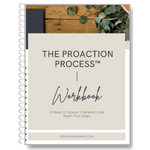
Need some tools to assist with the areas above? Check out our new ProAction Process™ Workbook packed full of tips, templates, worksheets, and exercises to support these areas of planning and more.
If you’d like a partner in helping you address your overwhelm and reach your goals, I’d love to talk. Reach out or schedule your free 30-minute consultation.

by Lori Vande Krol | Dec 19, 2022 | General Productivity, Goals and Priorities, Habits, Planning, Time Management
How has 2022 been for you? What went well? What could be improved? Did you reach your business and life goals? What will you do differently next year to grow further?
Before you do 2023 annual planning, it is a valuable exercise to close out the year and prepare for the new one by reviewing your goals, habits, and routines. Follow the steps below to review and reset for continued success.
1. Reflect
Look back on the past year and answer reflection questions such as:
- What did I accomplish this year?
- What am I proud of?
- What am I thankful for?
- What should I celebrate?
- What will I continue to do that contributed to my success?
- What were my challenges this year?
- What could/would I have done differently?
- What is one thing I could do to improve next year?
Set aside focused time to write your answers to these questions. You may be surprised at what you learn about yourself, your systems and habits, and how to address challenges in the upcoming year.
For example, during my Year in Review, I realized I am not diligent about scheduling time into my calendar at the beginning of each week for the “important but not urgent” tasks and projects. I, therefore, have not made the progress I wanted on many of these projects. I need to create a routine of setting aside time each week, just as I do with my exercise, before I build in other tasks and appointments. This will now be part of my planning process for 2023.
2. Review Your Annual Goals
The second step in your Year in Review is to review the status of your current year annual goals – both professional and personal. What goals are complete? What contributed to that success? Do you have goals that are not complete, or were not even started? If so, what challenges prevented their completion? Or perhaps there was a change in priority or focus during the year. Determine which of these goals should remain for the upcoming year and write any notes to carry into your 2023 annual goal setting.
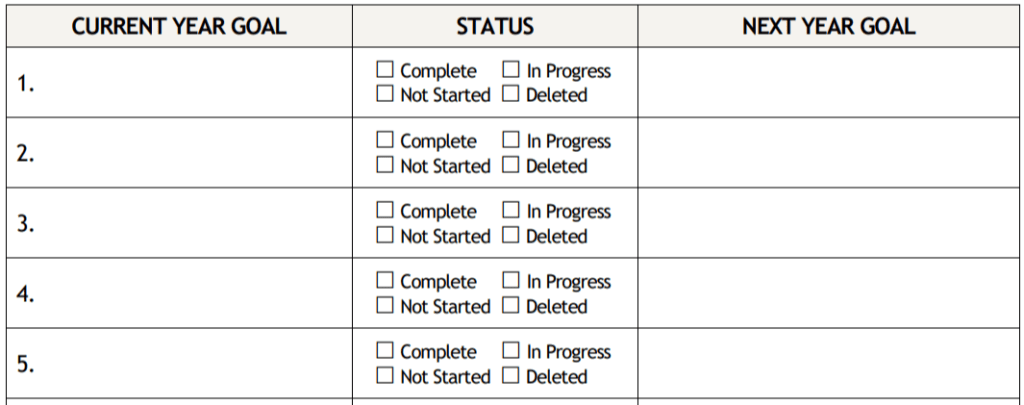
3. Analyze Your Habits and Routines
How did you do on your goals and progress related to your defined habits this year? Review your habit tracking tables and schedule time to reward yourself for any goals reached. Will these habits continue or grow?
For those habits that were a struggle, analyze the reasons and what needs to change in the upcoming year. Do you understand the deeper “why” for the habit? Do you have the right tools in place? Do you need an accountability partner or coach? Determine the habits you will stop, continue, or update for the upcoming year.
Similarly, review your current routines (or routines you had hoped to establish this year). Look at your morning, start of day, end of day, and evening routines. How are they working for you? Do they need to be adjusted or reset? Establish the routines you would like to implement in 2023.
To help you with your Year In Review, I have created a downloadable template to walk you through the process. Click below to have it emailed to you.
Year in Review Template
FREE DOWNLOAD
You can also find this template, along with other valuable planning exercises and templates, at ProActionPlanner.com. Get them soon as they will only be free until the of the year.
If you’d like assistance with review and reflection, the goal-setting process, or in setting up systems for success, contact Lori at Life Made Simple or schedule your free 30-minute consultation. I’d love to help!

by Lori Vande Krol | Jun 22, 2022 | General Productivity, Goals and Priorities, Motivation, Procrastination, Team Productivity, Time Management
I have a confession to make. Months went by this year before I finally took focused time to set my annual goals. While I help others to do this daily and understand the importance and benefit of annual goal setting, I was not able to complete the task for myself. I took some time to reflect on my reasons for procrastinating on this task, which helped me to work through and complete the process. Following are a few reasons you might find goal setting difficult as well as some tips and resources to make it simpler.
1. The goal, outcome, or supporting actions, are unclear.
Too many times, I have gotten hung up on taking action because the end result, or the full range of steps I need to take to get there, is not completely clear. I have to remind myself that taking some action is better than nothing at all. Often, as you start to take action the goal and end result becomes clearer.
In his article, The Goal is Not the Point, James Clear says: ” In other words, your goal becomes your compass, not your buried treasure. The goal is your direction, not your destination. The goal is a mission that you are on, a path that you follow. Whatever comes from that path—whatever treasure you happen to find along this journey—well, that’s just fine. It is the commitment to walking the path that matters.”
When the goal or destination is not clear, consider your goal a direction you are heading, and clarify the end result as you go.
2. Setting big goals is scary.
There are many fears that can hold us back from setting and achieving goals. “What if I fail?” or “What if I succeed? Can I handle it? What comes next?” Perhaps it is a fear of change or a fear of losing control that is holding you back. In times like this, you must ask yourself, “What happens if I don’t try?”
Are you willing to live with more of the same? The status quo? Or are you willing to accept some risks and potential challenges in order to grow and achieve more? What great things might happen, for yourself and others, if you succeed? Take time to evaluate your fears. Learn what is driving the fear and anxiety in order to push forward. You may find that you even enjoy the journey.
3. Goal setting has not been successful in the past.
Last fall I was presenting a course on procrastination. When discussing potential reasons for procrastination, I shared that we often fail to take action when the end goal is unclear. An attendee raised her hand and asked, “What is the point of setting goals? It never works.” I challenged her to think more deeply about her hesitation toward goalsetting. I asked if there was possibly something else holding her back. After the presentation, we talked further, and I learned that she had worked for large corporations most of her career. Those companies would go through the annual goalsetting process, but it would end there. Management would not follow through or follow up on the actions required to achieve those goals. Goals were not reviewed regularly. Employees were also unclear on how the company’s goals tied to their own vision and goals. The lack of a full system for goal setting and implementation caused it to fail, and employees no longer trusted the process.
If goal setting has not been successful for you in the past, reflect on the true reasons for this. What can be done differently to improve your chances of success? There are many tools and tips to support individual, team, and company goalsetting. The systems and processes used need to work for everyone involved. Below I share additional resources for successful goalsetting.
The potential reasons for avoiding the task of goal setting are not unlike the reasons for procrastinating any task. The first step is working to understand your unique reasons for avoidance and then to find the right tool and process for you and/or your team. There is no doubt you will grow and achieve more.
Additional Resources for Goal Setting
Goal Setting: A Scientific Guide to Setting and Achieving Goals by James Clear
Mastering Time Management: What To Do Before the To-Do List by Lori Vande Krol
Do You Have a Lot of Big Goals? Focus on What You Know and Love by Lori Vande Krol
The Superman: Goal Achieved by Lori Vande Krol
The ProAction Planner™: a system to turn your annual goals into action throughout the year
FREE DOWNLOAD: Use the button below to receive a free Annual Goal Setting Template
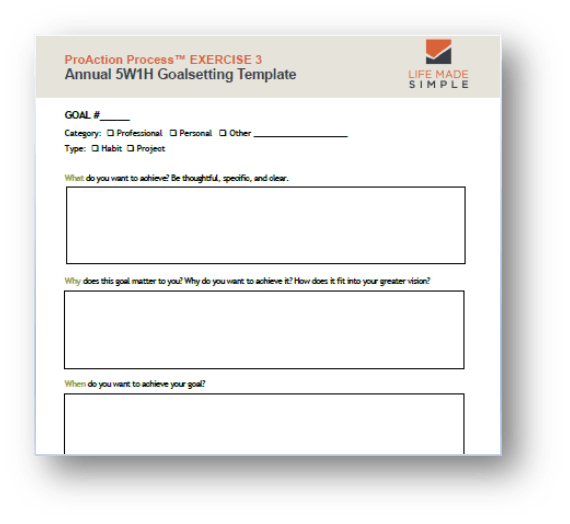
Annual 5W1H Goalsetting Template
FREE DOWNLOAD
It is not too late to set your annual goals for this year! If you’d like assistance with the goal-setting process, or in setting up systems for success, contact Lori at Life Made Simple or schedule your free 30-minute consultation. I’d love to help!




 The schedule may be the same every day or may differ throughout the week. In the example above, Tuesday and Thursday have the same “themed schedule” while the other days look different. In the resources section below I share a template called My Productive Week that can be of great assistance in defining your daily “theme blocks.”
The schedule may be the same every day or may differ throughout the week. In the example above, Tuesday and Thursday have the same “themed schedule” while the other days look different. In the resources section below I share a template called My Productive Week that can be of great assistance in defining your daily “theme blocks.”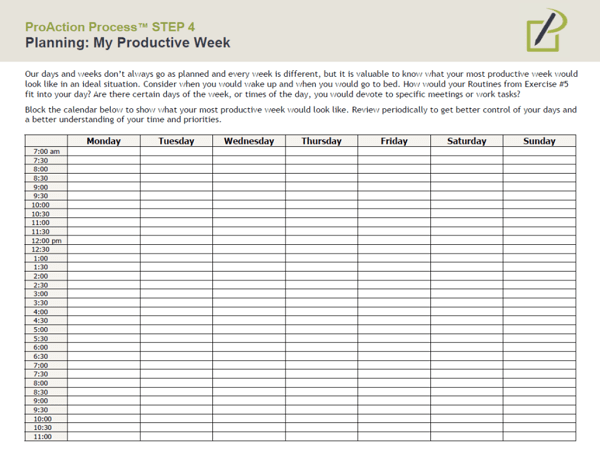

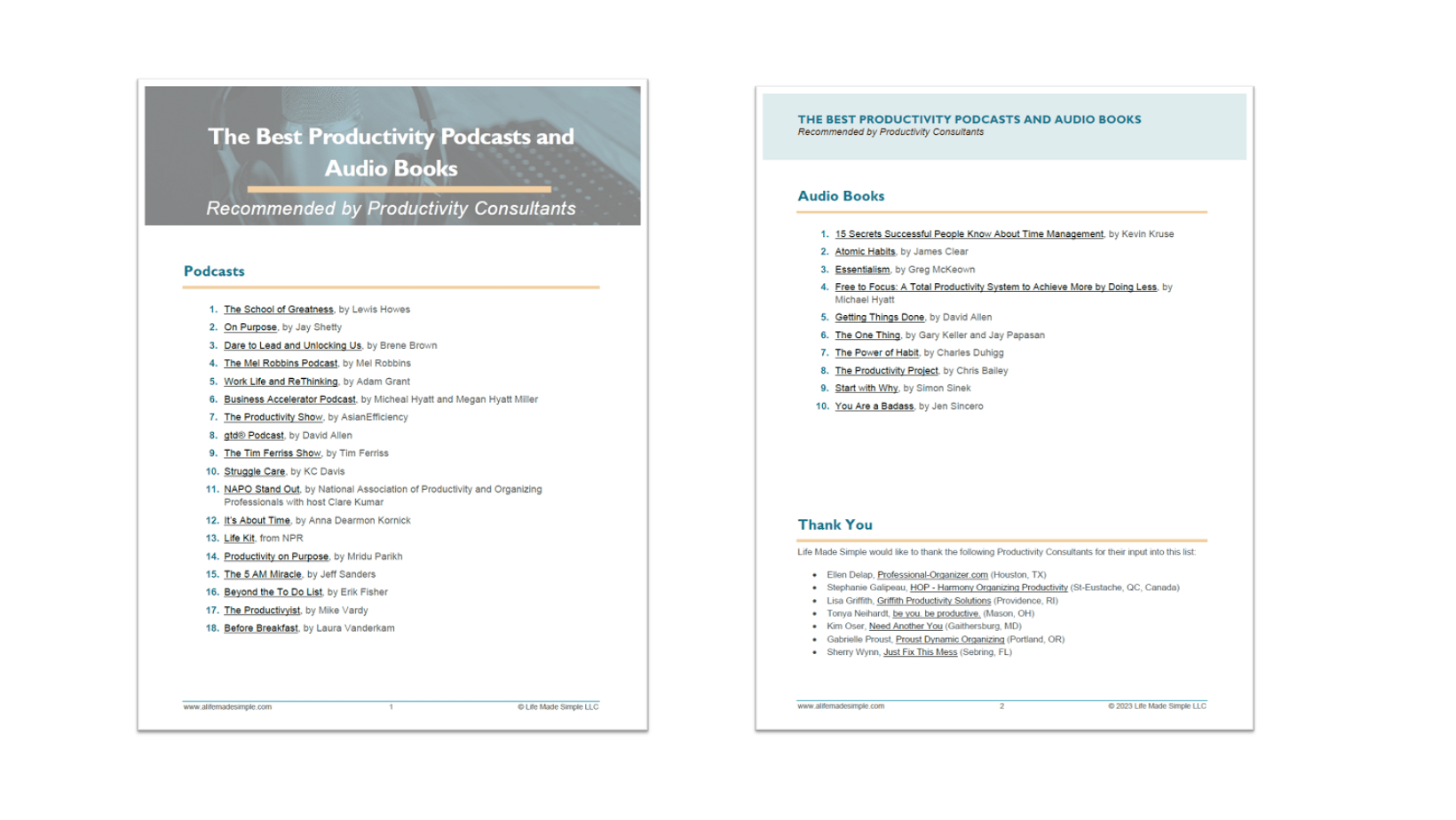

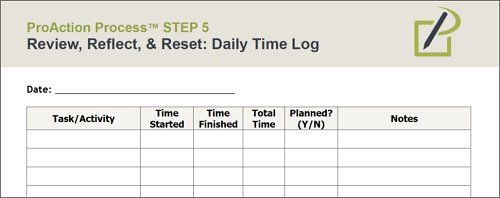





Recent Comments